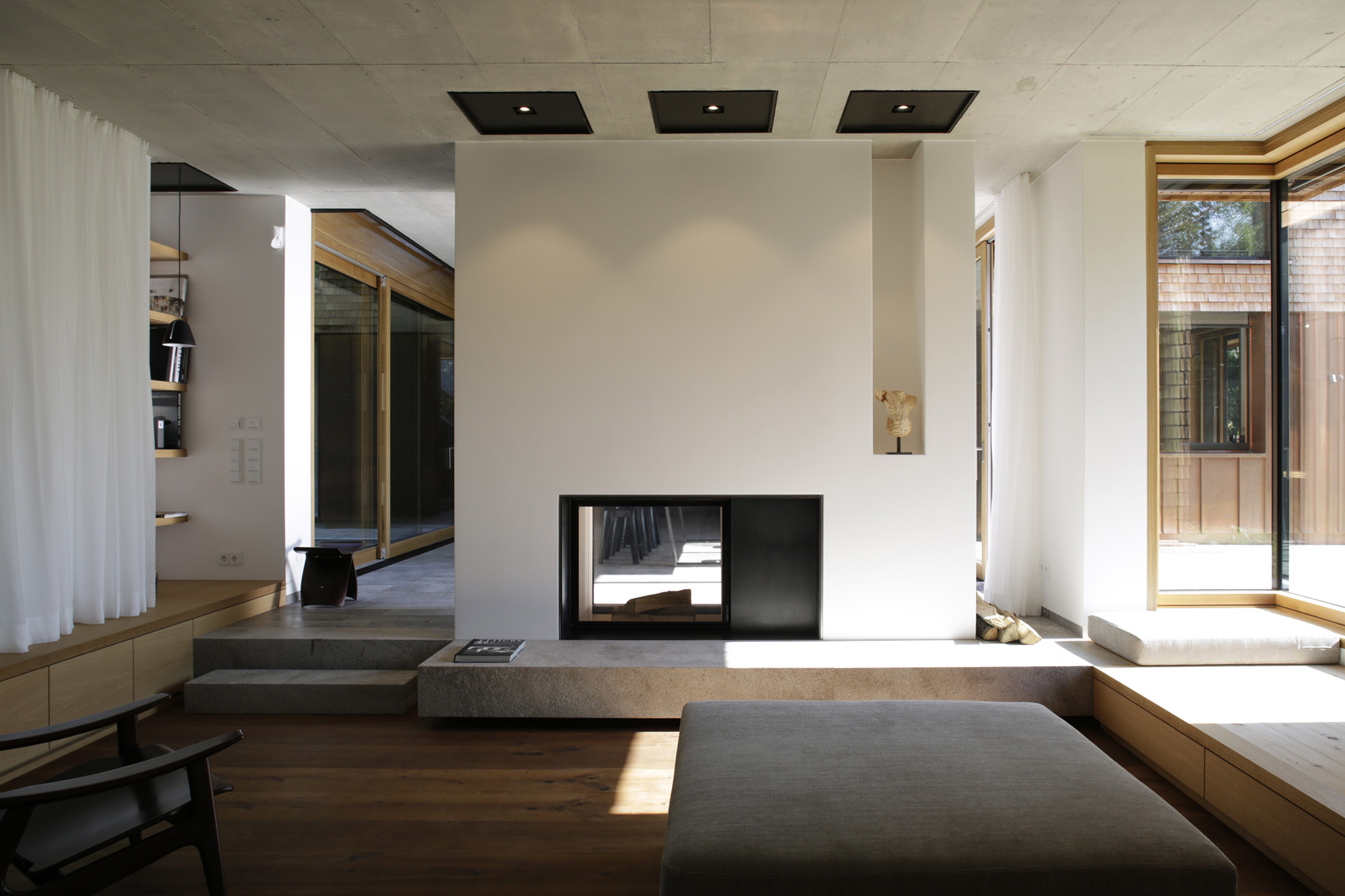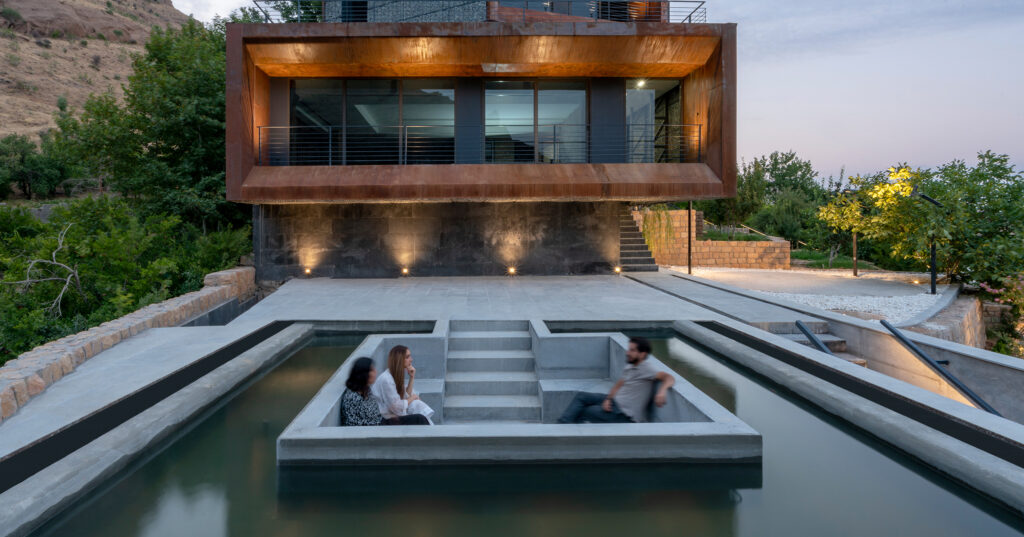Architects: Want to have your project featured? Showcase your work by uploading projects to Architizer and sign up for our inspirational newsletters.
Don Draper was undoubtedly a flawed man, but unlike his moral compass, his taste in interiors (and two-piece suits) was rarely in question. Fans of the 2010s AMC series Mad Men will likely recall the stunner of a mid-century East-Side apartment that the advertising creative director, played by actor Jon Hamm, shared with his wife Megan from Season 5 onward. The swoon-worth penthouse was decked out with all the old favorites, walnut veneer, grasscloth wallpaper, the obligatory Eames chair and ottoman, and of course, the star of the show, the sunken lounge pit, complete with brown sectional and thick white carpet. This particular design feature was a staple of the 60s.
Decades later, that drop in the floor, a place where cocktails were poured and secrets were spilled, is becoming a fan favorite. Back on the mood boards of architects and interior designers everywhere and far from being a mere nostalgia trip, the lowered lounge arrangement is proving itself a relevant reflection of modern living as people increasingly host casual gatherings at home and crave environments that encourage conversation and authenticity.
The Gables by Patalab Architecture, London, United Kingdom
It would be unfair to credit Draper for starting the trend. In reality, the conversation pit owes its mainstream breakthrough to the 1957, Miller House in Columbus, Indiana, built by the Finnish American architect and industrial designer Eero Saarinen. Saarinen, also known for the Womb chair, the arching Gateway Arch in St. Louis and the winged TWA Flight Center in New York, approached furniture design as an extension of architecture with material, form and function being intrinsically linked to the building a piece was occupying.
By the late 1960s, conversation pits were the epitome of cool, popping up regularly in design magazines and the homes of the fashion forward. Bold color schemes, thick, fuzzy carpeting and low-hanging pendant lamps typified the style. Over time, however, shifting tastes, the rise of open-plan living and changes in building codes made the sunken lounge a passing novelty. Many boarded over their drop-down floors in the name of minimalism, relegating conversation pits to the design archives — until now.
Today, a blend of changing social habits and tightening budgets has revived desire for the sunken lounge. Rather than spending on pricey dinners and noisy bars, many people are choosing to host at home. Themed cocktail nights, craft sessions, board-game marathons and watch parties are taking over living rooms. While grocery subscription boxes are making even the most wary cook try their hand in the kitchen, grazing boards are regularly a trending topic on social media. One of the challenges in these scenarios is ensuring guests remain together. No one wants to be sat in a line on the sofa, especially if you’re the one on the end, craning your neck as you try to keep track of the conversation.

Villa Alley by DALL OFFICE, Ghalat, Iran
By lowering a section of the floor, a conversation pit creates an intuitive boundary — no walls needed. Everyone settles at roughly the same eye level, invited into the same circle of chatter and shared snacks. Lounge pits mean no perching on mismatched stools, without a place to sit your plate or glass and less chance of satellite groups drifting off into separate corners and conversations.
However, bringing a conversation pit into a contemporary home requires thoughtful planning. Structural layout can cause big issues. Unsurprisingly, it’s not easy to cut a hole into your floor that wasn’t designed to be there. Some projects will face limitations. There may be hidden ductwork or load-bearing beams that restrict how low one can realistically go. New builds have an advantage here. Designers can incorporate a pit from the start, ensuring that the foundation, framework and any underfloor utilities are accounted for.
Or, if that’s not an option, many modern iterations follow the fake-it-til-you-make-it line of design, steps up, and then back down to give the impression of a sunken floor without any structural modifications. While some furniture manufacturers are making modular sofas that can be configured like a lounge pit saving the need for any permanent modifications.

House Boogert by Borren Staalenhoef Architects, Epe, Netherlands | Photos by Pieter Kers
Being an invention of the 60s, conversation pits thrive on tactile and inviting materials. Wool-blends, suede and corduroy are all classics. But a bold, retro pattern will always work well in a lounge pit. Open-plan homes can suffer from acoustic reverberations, so dropping the floor encloses the space while the seating acts as sound baffles, meaning conversation stays clear and intimate. Large, overstuffed cushions can help with this too, not only encouraging extended lounging but also helping absorb and dampen sound.
Many critics call them dangerous — hazardous and awkward. Now, of course, no one wants their guests — or children — tripping into a pit. However, the best designs address this by installing broad, shallow steps and lighting them with discreet, warm LEDs. An unassuming timber rail or a raised wraparound ledge can double as a safety feature while also working as a makeshift side table. If accessibility is a concern, designers might integrate ramps or wider landing pads so that everyone, including those with wheelchairs or limited mobility, can enter and exit comfortably.

House L011 by Stephan Maria Lang Architects, Munich, Germany
This is particularly important in public settings. Though famed for its role in private homes, the sunken lounge is making inroads in hospitality and work environments, too. Hotels, keen to cater to a wide variety of guest needs through day into night, can incorporate pits in their lobbies or lounge bars, giving visitors a cozy corner to converse over coffee or linger over drinks. Equally, co-working studios that typically look to be flexible in their seating offerings can also be seen regularly devoting a recessed seating area to help facilitate informal meetups.
Mostly, the comeback of the conversation pit highlights our collective desire to reconnect in person. Digital entertainment dominates daily life, and yet people still crave face-to-face interaction. A slightly dropped seating area, ringed in plush, enveloping and textured cushions, prompts everyone to lean in and talk. There is no corner seat left out of the loop, no wide gap between participants. It is a small tweak in spatial planning but one that can profoundly change how a group interacts.
It would be easy to dismiss the lounge pit as a piece of 1960s nostalgia, best left to Don Draper and his questionable after-hours conduct. Yet its reappearance suggests it addresses genuine needs in modern life: the push for intimate social zones that do not eliminate the open flow of contemporary homes. By lowering a section of the floor instead of throwing up partition walls, designers preserve the sense of a spacious layout while carving out a natural space for social interaction to refocus our attention and bring people together.
Architects: Want to have your project featured? Showcase your work by uploading projects to Architizer and sign up for our inspirational newsletters.

